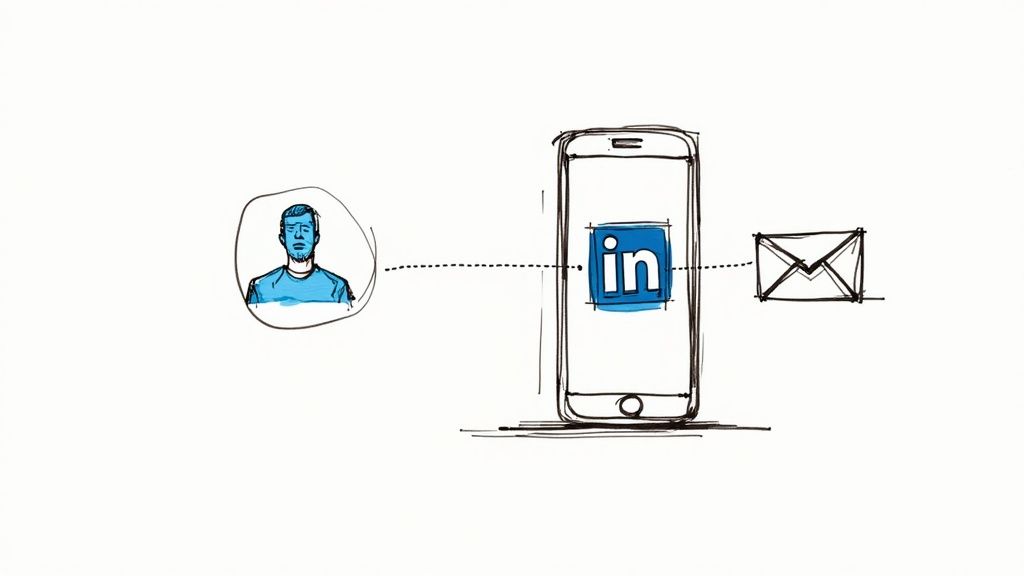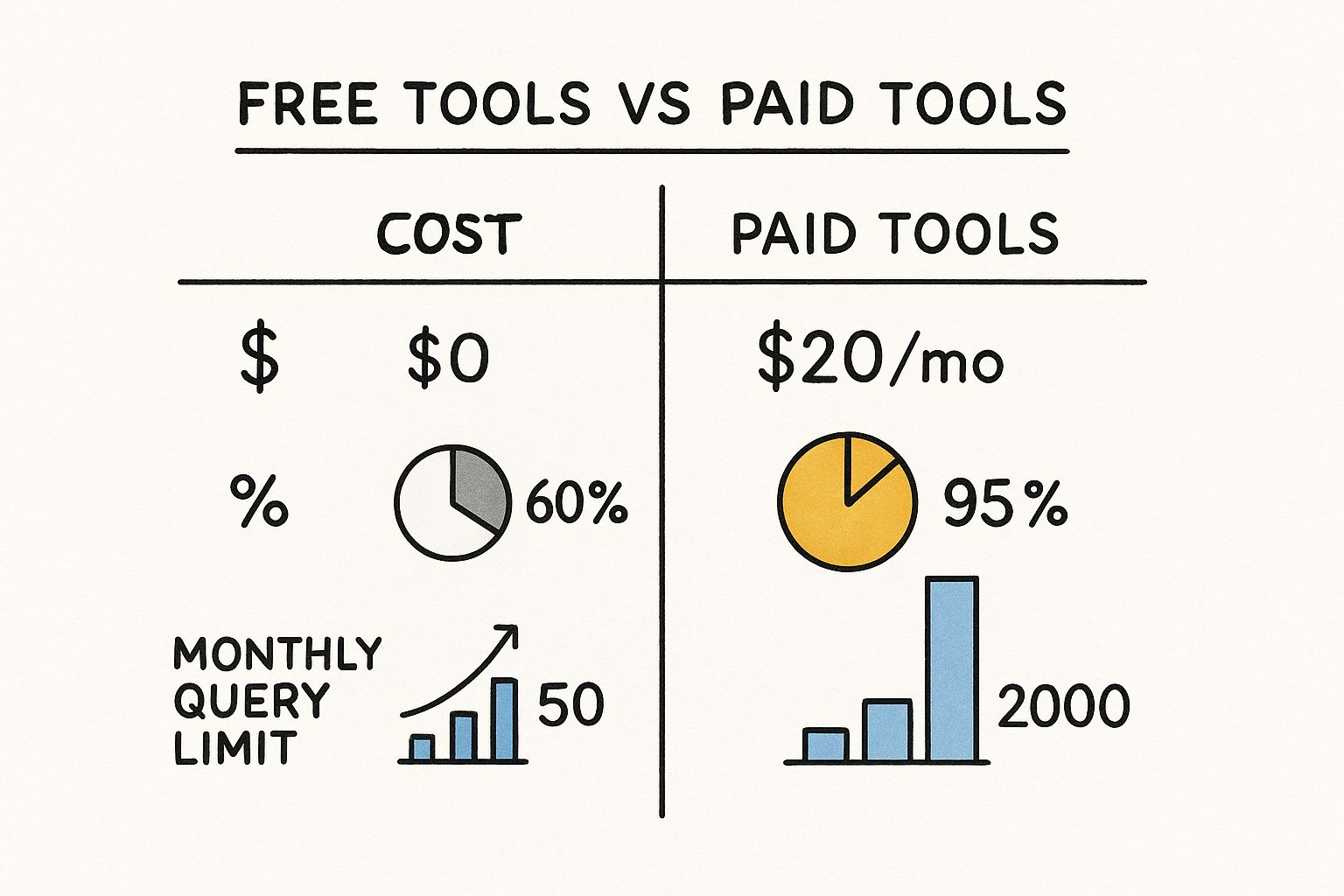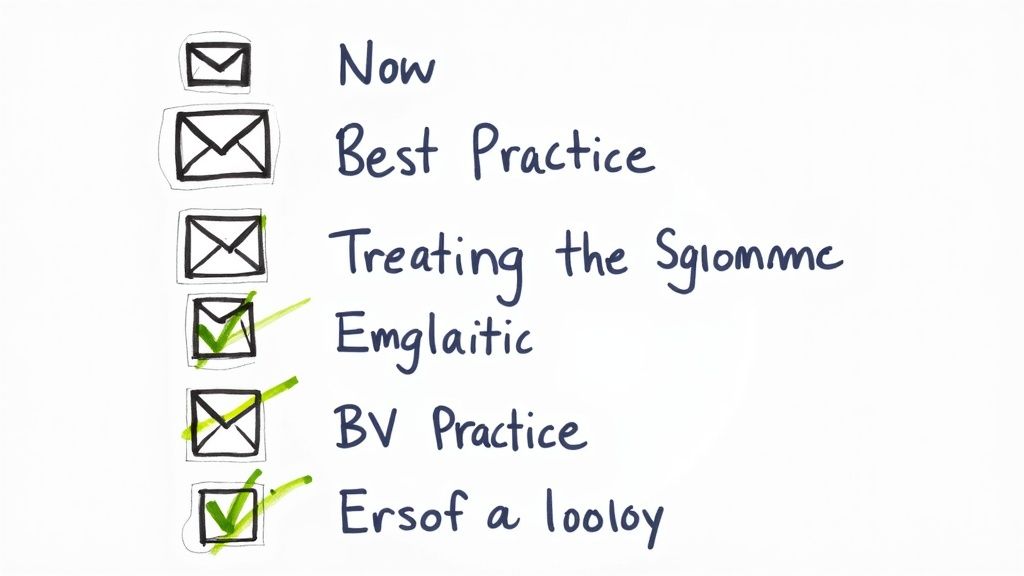Finding a company email address boils down to a few core methods I've used time and again: good old-fashioned manual searching on their website, making an educated guess based on common patterns, and firing up a dedicated email finder tool. Honestly, the most effective approach is usually a mix of all three to track down and double-check that you've got a direct line of communication.
Why Finding the Right Email Is a Game Changer

In a world overflowing with automated LinkedIn messages and ridiculously crowded social media feeds, a direct email is your secret weapon for cutting through the noise. Getting good at finding the right email address isn't just a technical skill—it's a massive strategic advantage that gives you a direct pass to the people who actually make decisions.
Think about it. Sending your message to a generic info@company.com address is like throwing it into a black hole. It gets filtered, maybe forwarded, or—most likely—completely ignored. A direct email to a specific person, however, skips all the gatekeepers and lands exactly where you need it to.
This isn't just about finding a contact detail; it's about unlocking a direct line to opportunity. Whether you're in sales, marketing, or recruitment, the ability to reach the right inbox is the first step toward building a real professional relationship.
Before we dive into the how, let's quickly recap the main strategies. Each has its place, and knowing when to use which is half the battle.
Primary Methods for Finding Company Emails at a Glance
This table gives a quick rundown of the main strategies we'll cover, highlighting where they shine and the effort you can expect to put in.
As you can see, while you can definitely find emails manually, using the right tools is a much smarter way to work, especially when you need results at scale.
The Power of a Direct Connection
A personalized email to the right individual can open doors that are slammed shut to everyone else. It shows you've actually done your homework and are serious about making a genuine connection. This simple act immediately sets you apart from the crowd that blasts out generic messages and gets minimal results.
The benefits of going direct are pretty clear:
- Sky-High Response Rates: A message sent straight to a person's inbox is far more likely to be opened and replied to than one dumped into a general mailbox.
- Bypassing the Gatekeepers: You get to talk directly with managers, VPs, and department heads without having to navigate administrative assistants or automated phone trees.
- Building Real Relationships: Kicking off a conversation with a thoughtful, personalized email is the bedrock of any solid, long-term professional connection.
Why Email Still Runs the Business World
Despite all the new platforms popping up, email is still the undisputed king of professional communication. And it's not going anywhere. Projections show that by 2025, a staggering 376.4 billion emails will be sent every single day worldwide, with the global user base hitting 4.6 billion. You can dig into more of these email usage trends over at smtp2go.com.
This incredible volume just confirms what we already know: nearly every professional on the planet relies on email, making it the most dependable channel for getting business done.
Understanding how to find those company email addresses gives you a powerful tool for growth. Our full guide on finding company email addresses dives even deeper with more actionable strategies to help you connect with anyone. By mastering these techniques, you stop hoping your message gets seen and start ensuring it gets delivered.
Mastering Manual Search Techniques
Before you even touch an automated tool, it’s worth spending a few minutes playing digital detective. Honestly, some of the most reliable and satisfying finds come from simple, clever manual searches. This approach costs nothing but a bit of your time and can uncover emails that tools often miss, especially for smaller or newer companies.
The goal here isn't to just randomly browse a company's website. We're going to use targeted search engine queries to essentially force Google to show us contact information that's hiding in plain sight. Think of it as knowing the secret knock to get information buried deep within a website's archives.
Using Advanced Search Operators
Google’s real power is unlocked with its advanced search operators. These are just simple commands you add to your search to narrow down the results with incredible precision. For finding company emails, a few of these are pure gold.
The most valuable operator is easily site:. This command tells Google to search only within one specific website. When you combine this with a person's name and keywords like "email" or "contact," you can scan an entire domain for their details in seconds.
Let's walk through a real-world example. Say you're trying to find the email for a marketing manager named "Sarah Chen" at a company called "Innovate Corp," and their website is innovatecorp.com.
You could pop this into Google:
"Sarah Chen" email site:innovatecorp.com
This tells Google to find pages only on innovatecorp.com that contain the exact phrase "Sarah Chen" along with the word "email." It’s a simple query, but it’s a remarkably effective place to start.
Refining Your Search Queries
Sometimes that first search doesn't land you a direct hit. No problem. This is when you get a bit more creative with your search terms and operators. The key is to think like a webmaster: where would an email address be publicly listed?
Here are a few variations I use all the time:
- Broaden the Keywords: Swap "email" for other terms. Try
contact,bio, or even just the "@" symbol. For instance:"Sarah Chen" @innovatecorp.com site:innovatecorp.com. - Search Press Releases: Company press releases are a treasure trove of contact info for media inquiries. Tweak your search to look for them:
"Sarah Chen" press release site:innovatecorp.com. - Check Blog Posts: If the person has written for the company blog, their email might be in their author bio. Try something like:
"Sarah Chen" author site:innovatecorp.com/blog.
The logic here is simple: you're tracing the digital footprint an employee leaves on their company's domain. Most people have no idea how much of this info is out there until you know exactly how to look.
Another powerful operator is inurl:. This one tells Google to only show results where your keyword is in the page's URL. This is perfect for digging up specific sections like a company directory or team page.
A query might look like this:
site:innovatecorp.com inurl:team
Once you land on the team page, a quick CTRL+F (or CMD+F on Mac) for the person’s name or the "@" symbol can often reveal exactly what you're looking for.
Exploring the Company Website Directly
Beyond Google, the company's website is packed with clues. Don't just skim the homepage; dive into the less-trafficked sections where contact details are often posted for very specific reasons.
Here’s my checklist of pages to hit:
- About Us or Team Page: This is the obvious first stop. Even if only senior leadership emails are listed, it can help you confirm the company's email format (e.g.,
firstname.lastname@company.com). - Press or Media Room: This section is built for journalists and almost always includes direct contact information for marketing, PR, or communications staff. Goldmine.
- Blog or Articles: Check the byline on any articles written by your target. Author bios at the top or bottom of a post are common places for a direct email.
These manual techniques build a solid foundation for any email-finding mission. By combining them, you can often find what you need without paying for a single tool. If you want to dive deeper, our guide on how to find email addresses for companies offers more strategies to build on these skills. Mastering these detective-like tactics will make you far more effective at making the connections that matter.
The Art of the Educated Guess

So your advanced searches came up empty. It happens. This is where we shift from being a detective to being a pattern-spotter. Most companies, particularly the big ones, stick to a standardized format for their email addresses. That consistency is your secret weapon.
Making an "educated guess" isn't about throwing spaghetti at the wall to see what sticks. It's a logical process of deduction. Once you get a feel for the most common corporate email patterns, you can predict a specific address with surprising accuracy. I've found this method to be incredibly effective and a massive time-saver.
Decoding Common Email Patterns
Companies love predictable formats. It simplifies their internal management and makes everything uniform. After years of doing outreach, I can tell you that almost every business email you'll ever need to find falls into just a handful of structures. Getting familiar with these is your first move.
These are the patterns you’ll run into 9 times out of 10:
firstname.lastname@company.com(e.g., jane.doe@company.com)flastname@company.com(e.g., jdoe@company.com)firstinitial.lastname@company.com(e.g., j.doe@company.com)firstname@company.com(e.g., jane@company.com)firstnamelastinitial@company.com(e.g., janed@company.com)
Sure, there are other weird variations out there, but these five account for the vast majority. Your job is to figure out which one your target company uses.
The Reverse-Engineering Trick
Here's my go-to tactic, and it almost never fails: find just one verified email address from the organization. That's all you need. With a single known example, you can reverse-engineer the format for everyone else on the team.
But where do you find that first email? Start with the public-facing contacts. A company’s "Media" or "Press" page is a goldmine, as they often list a direct email for a PR manager. Sometimes even signing up for a newsletter will reveal a person's direct address instead of a generic "contact@" inbox.
Pro Tip: Let's say you find an email for Sarah Smith that's
s.smith@targetcorp.com. You've just cracked the code. You can now be pretty confident that the CEO, John Davis, has the emailj.davis@targetcorp.com.
This simple trick turns a wild guess into a calculated hypothesis. You're not just hoping you're right anymore; you're applying a proven formula.
Verifying Your Guesses Without Sending an Email
Okay, you've analyzed the patterns and pieced together what you think is the right email. Now what? The absolute worst thing you can do is fire off a "test" email to see if it bounces. It's unprofessional, and it's a fast track to getting your domain flagged for spam.
The right way to do this is with an email verification tool. These services let you check if an email address is valid and can receive mail without ever sending a message. They essentially ping the server to confirm the mailbox exists and give you an instant thumbs-up or thumbs-down.
Here’s a quick rundown of how it works:
- Generate Your List: Based on the common patterns, create a short list of possibilities. For Jane Doe at Acme Inc., that might be
jane.doe@acme.com,jdoe@acme.com, andj.doe@acme.com. - Use a Verifier: Plug those guesses into a free email verification tool. Many platforms offer one, including our own tool here at PlusVibe.
- Analyze the Results: The tool will spit back a status for each guess—usually "Valid," "Invalid," or "Accept-All" (which is a bit risky). A "Valid" result is your green light.
This verification step is non-negotiable. It protects your sender reputation and makes sure your perfectly crafted message actually has a shot at being read. By combining pattern recognition with instant verification, you turn guessing into a precise science and seriously boost your success rate from day one.
Using Social Networks to Find Emails
Let’s be honest, manual searches and educated guesses can only get you so far. When you absolutely need to pinpoint the exact person behind a job title, professional networks are your next stop. Platforms like LinkedIn aren't just for making connections; they're massive, searchable databases just waiting for you to find the right person.
This is where you get to combine a bit of social sleuthing with the pattern-guessing techniques we’ve already covered.
The real magic of a platform like LinkedIn is its structured data. You can filter by company, job title, location, and industry to zero in on exactly who you want to reach. Say you're looking for the "Head of Marketing" at a tech startup in Austin. A few clicks and you’ve built a specific search that spits out a shortlist of potential contacts in seconds.
Turning a LinkedIn Profile into an Email
Once you've found your target, their LinkedIn profile gives you the critical puzzle pieces: their first name, last name, and the company they work for. That's all you really need to start building out their likely email address.
Let’s imagine you’re trying to contact a "James Rodriguez" who works at "Apex Solutions." Armed with this info, you can circle back to those common email patterns:
james.rodriguez@apexsolutions.comjrodriguez@apexsolutions.comj.rodriguez@apexsolutions.comjamesr@apexsolutions.com
You’re no longer guessing in the dark. Instead, you've created a small, targeted list of highly probable emails. The next move is to run these through an email verification tool to see which one is active—without sending a single risky test email that could bounce. It's a simple, methodical process: identify, construct, and verify.
The goal is to combine social intelligence with technical verification. You use LinkedIn to find the person and their details, then apply pattern analysis and verification tools to confirm their digital mailbox.
Looking Beyond LinkedIn
While LinkedIn is the undisputed champ for B2B prospecting, don't sleep on other platforms. Twitter (now X) can be surprisingly useful. Many professionals—especially in tech, marketing, and media—put a contact email right in their bio for press or collaboration requests. A quick scan of their profile page can sometimes give you exactly what you need with zero effort.
GitHub is another goldmine, particularly for finding developers' and engineers' email addresses, as they are often public on their profile pages. The key is to think about where your target audience hangs out online and look for clues. You can streamline this whole process even further and learn how to automate prospect research to make your workflow that much smoother.
Why a Valid Email Matters So Much
Getting a valid email isn't just a nice-to-have; it’s absolutely critical for effective outreach. Think about how often people check their email—a staggering 88% of users check their inboxes multiple times a day. For business outreach, that means a message sent to the right company email address will likely be seen fast, which dramatically increases your chances of getting a response. You can dive into more email marketing statistics on Optinmonster.com to see just how plugged-in professionals are.
This high level of activity is precisely why your efforts matter. By using social networks to accurately identify individuals and construct their correct email, you ensure your message doesn't just get sent—it gets delivered to an active inbox, ready to be opened.
When you're serious about outreach, manual searches and guesswork just won't cut it. Trying to find email addresses for dozens, let alone hundreds, of prospects is a recipe for burnout. This is where you bring in the specialists: tools built specifically to find and verify professional emails at scale.
Email finder tools take the entire discovery process off your plate. They tap into huge databases, run slick algorithms, and perform real-time checks to pull up accurate contact info in a flash. Instead of you playing detective, these platforms do the heavy lifting, giving you back the time to actually write a compelling message.
The market is crowded, though. You've got everything from simple browser extensions that latch onto LinkedIn to heavy-duty platforms that can chew through a CSV of prospects in minutes. Knowing the difference is crucial for picking the right tool for your job and budget.
Free Tools vs. Paid Solutions
Your first big decision is whether to stick with free tools or invest in a paid subscription. "Free" always sounds good, but you have to know what you're giving up in accuracy, volume, and features. Free tools are great for one-off searches or if you're just dipping your toes in, but they usually cap your monthly searches and have a lower hit rate.
Paid tools, on the other hand, are built for people whose business depends on outreach. You get much higher accuracy, more monthly credits, bulk processing, and often some killer extras like data enrichment and API access.
This breakdown shows the typical trade-offs between free and paid email finder tools, giving you a clear picture of what you get for your money.

As you can see, while free tools are a solid starting point, paid solutions deliver the reliability and horsepower needed for any serious outreach campaign.
How These Tools Actually Work
It's not magic. These tools use a smart mix of methods to track down and confirm email addresses. Once you understand the process, you can appreciate the value they bring and better interpret their results.
Most high-quality email finders follow a three-step dance:
- Pattern Analysis: The tool starts by figuring out the most common email format for a company’s domain (like
first.last@company.com). - Database Check: It then scans its massive historical database—we're talking billions of professional emails—to see if it already has a match for your prospect.
- Real-Time Verification: This is the most important part. The tool performs a live check with the company's mail server to confirm the email address is real and can actually receive messages.
That final verification step is what separates the great tools from the mediocre ones. It gives you a "confidence score" or a clear "verified" status, so you can hit send without crossing your fingers.
Key Features to Look For
It's easy to get lost in the feature lists when comparing tools. But from my experience, there are a few non-negotiables if you're serious about effective outreach.
- Bulk Email Finding: Being able to upload a list of names and companies and get back a clean list of verified emails is a game-changer for large campaigns.
- LinkedIn Integration: The best tools offer a browser extension that works right on LinkedIn profiles. You find a prospect, you click a button, you get an email. Simple.
- Built-in Verification: A tool should never just hand you a possible email; it needs to confirm it. Look for platforms that are upfront about their verification process and provide confidence scores.
- Data Enrichment: The top-tier tools do more than just find an email. They can pull in extra data points like job titles, company size, location, and even social media profiles.
A platform like PlusVibe is a good example of this, bundling these features into a single workflow. This lets you find, verify, and manage your prospects all in one spot, saving you from juggling multiple subscriptions.
Comparison of Popular Email Finder Tools
To help you navigate the options, here’s a quick comparison of some of the leading email finder tools on the market. Each has its strengths, so the "best" one really depends on your specific needs, from solo prospecting to full-scale team campaigns.
This table should give you a solid starting point. Remember to check out their free trials or freemium plans to get a feel for the interface and accuracy before committing to a paid plan. The right tool should feel like a natural extension of your workflow, not another complicated piece of software to manage.
Even with a "verified" status from a top tool, it’s smart to take one final step to protect your sender reputation. Our detailed guide on how to validate email addresses explains why this is so critical for deliverability. An email finder gets you the address; a validator makes sure it’s safe to use.
Got Questions? We’ve Got Answers.

Diving into the world of email outreach can bring up a lot of questions, especially when you're trying to do things the right way. We get it. Here are some direct answers to the most common queries we hear about finding company email addresses.
Is It Legal to Find and Use Company Emails?
This is a big one, and the short answer is: it depends. The rules change based on your location, your prospect's location, and what your message is about. Regulations like GDPR in Europe and CAN-SPAM in the U.S. have very specific guidelines.
For B2B outreach, it's often permissible as long as there's a "legitimate interest." The key is that you must always give people a clear and simple way to opt out of future emails. Your message also has to be relevant and straightforward, not misleading. When in doubt, it’s always a good idea to chat with a legal professional to make sure you're fully compliant.
What's the Most Reliable Way to Find an Email?
Honestly, there’s no single "best" method. The most reliable approach is always a combination of different strategies. A high-quality email finder tool gives you a great mix of speed and accuracy, but you can't stop there.
For the highest level of confidence, you need a multi-step process:
- First, pinpoint your prospect using LinkedIn or good old-fashioned manual searches.
- Next, use a dedicated finder tool to generate the most likely email address.
- Then, cross-reference that result by checking the company’s typical email pattern.
- Finally, run it through a separate email validation service to confirm it's deliverable.
This layered approach is your best defense against bounces and dramatically increases your chances of actually landing in the right inbox.
The ultimate goal isn't just to find an email—it's to confirm it's active and deliverable. A verified email is the foundation of any successful outreach campaign, protecting your sender reputation and ensuring your message gets seen.
How Can You Verify an Email Without Sending One?
Easy—you use a dedicated email verification service. These platforms run a series of technical checks in the background without ever sending a message, so your process stays completely professional and under the radar.
These tools check for proper syntax, confirm the domain is real and has a working mail server, and then ping that server to see if it recognizes the specific mailbox. This process tells you if an address is valid, invalid, or risky. To see exactly how this works, check out our guide on how to check if an email is valid.
What Should I Do with Multiple Possible Emails?
It happens. You find a few possibilities, like john.doe@company.com and jdoe@company.com. Your first move should be to prioritize the one that matches the most common format you've seen for that company.
After that, run all the options through an email verification tool. Nine times out of ten, the verifier will pinpoint the single valid address for you. In the rare case that more than one comes back as valid, just go with the more common professional format, which is usually firstname.lastname.
Ready to stop guessing and start connecting? PlusVibe combines powerful email finding, verification, and outreach tools into one seamless platform. Find the right emails and launch your next campaign with PlusVibe today!














































.jpeg)


.png)

















































